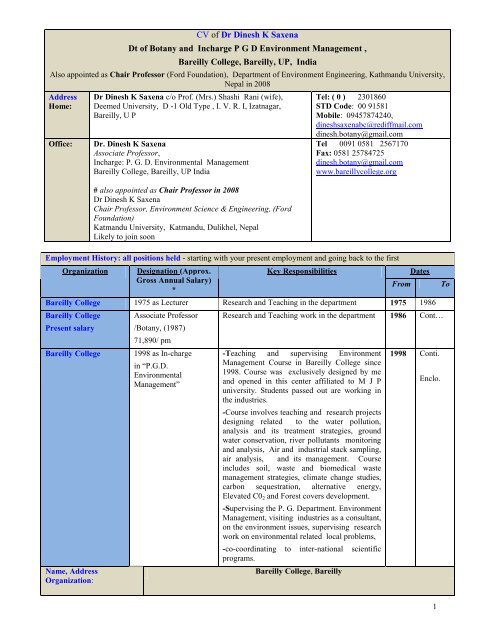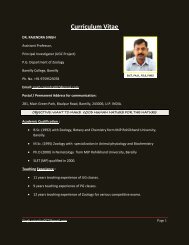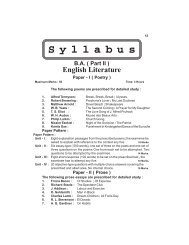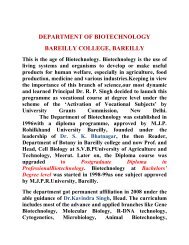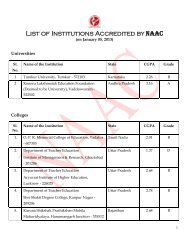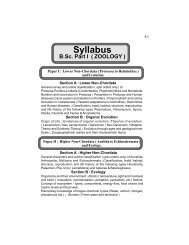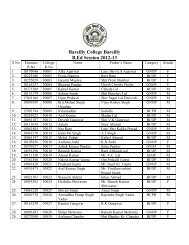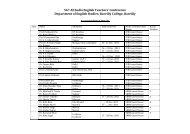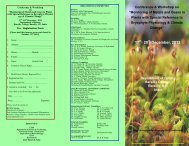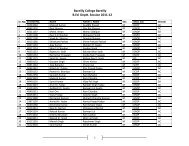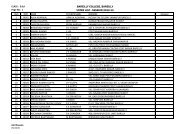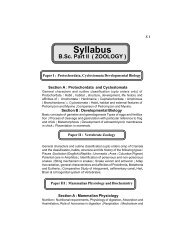Dr D K Saxena - bareilly college , bareilly
Dr D K Saxena - bareilly college , bareilly
Dr D K Saxena - bareilly college , bareilly
Create successful ePaper yourself
Turn your PDF publications into a flip-book with our unique Google optimized e-Paper software.
Designation and JobDescription:Interest and specialization(a) Associate Professor in BotanyManagement.(*)and Incharge of P. G. D. EnvironmentDepartment was established by me enrolls the 30 students every year for the environmentalEducation at graduate level. We teach ecology and different aspects of pollutions (air,water, industrial, noise, waste, radio-nuclides,) and their biological managements. It isto inform that we have all latest expensive instruments (personal and from the support ofnational funding agencies) used for the monitoring and analysis of water, air and industrialeffluent parameters.(a)Ecology and different aspects of pollutions (air, water, industrial, noise, waste,radio-nuclides,) and their biological managements(b) Carbon sequestration, C02 studies, Ozone studies, Climate change studiesAmongst the 80% instruments procured from different research projects belongs to PI (<strong>Dr</strong>Dinesh K <strong>Saxena</strong>), are: Atomic absorption spectrophotometer, UV-IR spectrophotometer,Metrological kit, Infra-red thermometer, GPS system with GPS track recorder, PhotoSystem, Photosynthetic Efficiency Analyzer, X-ray Fluorescence, Growth chamber, notebook, micro-Kjeldahl, Sauxhlet, Flame photometer, computers, BOD incubator withhumidity control device, Flow meter, Light meter, Soil pH meter, Soil moisture meter, Highvolume air sampler for CO 2 , NOx and SOx RSPM, SPM, Stack monitor, pH meter, Soilmoisture meter, Conductivity meter, Dissolved oxygen kit, Portable D. O. analyzer, D.O.electrode, -Modeling of Environmental parameters by Global Positioning satellite System(GPS).Growth chamber, turbidity meter,2
Visited Abroad(1984-2000) Several times in European Institutions (UK, Germany, Greece, Austria, Chech, France, Denmark, Swiss, Hungary)and three times in USA- Aquatic Weed Research cent at Gainesville Florida University of Florida, 1984.Enclos: Two times at Michigan Technological University (1989 & 2000), USA. -Recently from 19 th to 31st July, 2007.(2004-2009)Enclos: 2004: Hungary at Szent Istvan University , Hungary 2005: Hungary, Again at Szent Istvan University by the INSA-DST bilateral exchange Program visitingBilateral research Prog 2005 at Vienna to attend the International Bryological Meet. 2007 July, Malaya University to attend the International Bryological Conference. At Malaysia. 2007 September at Godollo Szent Istvan University, Hungary, INSA-HAS Bilateral Research Program 2007 December at Kathmandu University, for the invited lectures 2008 ABLS Meet in USA, 2008 2008 Ostrava Conference on Sustainable Environment in 2008 in Czech 2009 Germany in 2009 to attend the ICP meet in Feb 2-5 th 2010 Belgium to attend the 23 rd ICP meet. 1 to 4 th Feb 2010 at Belgium 2010 Russia at Dubna Nuclear Research Facility to initiate bilateral research research with Prof Marina for thethree weeks from the end of the March, 2010 to second week of the April.Contribution to the Department:INTERNATIONAL - REFERENCES:REFERENCE 1 REFERENCE 2 REFERENCE 3Name: Prof Janice M Glime Prof Vetezslav Plasak Prof. Haji Mohamed Abdul MajidAddress:Professor and PresidentMichigan TechnologicalUniversity,Houghton, 49331, USAHead, Environment BotanyDepartment, Faculty ofScience, University ofOstrava, Clitt ussiho 10-,Czech RepProfessor and HeadBiology DepartmentUniversiti Brunei Darussalam,Jalan Tungku Link, Gadong,Brunei Darussalam BE1410Email Id: jmglime@mtu.edu Vitezslav.phsek@osu.cz binabdulmajid@gmail.comTelephone Number: 906 487 2546 420 60 3346 00Organization:Michigan TechnologicalUniversity, USAUniversity of OstravaBiology DepartmentUniversity Brunei Darussalam,Designation:Professor and PresidentIABProfessor and HeadProfessor and ChairmanHead of Ph.D SchoolYour Professional Relationshipwith the Referee:Academics/ResearchEcologist, bryologistAcademics/ResearchBotanist/ecologist/environmentalistAcademician/Research, Expert on C0 2studiesEnvironmentalistReferences: Indian scientists to whom I know::(1) <strong>Dr</strong> Virendra Nath, Deputy Director, Director grade, National Botanical Research Institute, Rana Pratap Marg, Lucknow , Ph09415025032, drvirendranath2001@rediffmail.com, drvirendranath46@rediffmail.com5
(2) Professor Sunita Kapila, House No. 2368, Sector Chandigarh- Punjab, India 09872629092 s_kapila0802@yahoo.co.in(3) Prof P B Khare, Deputy Director, National Botanical Research Institute, Lucknow, India kharepb@yahoo.com(4) <strong>Dr</strong> M M Swamy, Professor and Head, Department of Environmental Engineering, S.J. College of Engineering, Mysore - 570 006,Karnataka, India, mmswamy_20@yahoo.com(5) Prof S P Singh, Hon Vice Chancellor, H N B University, Srinagar, Garhwal, surps@yahoomail.com(6) <strong>Dr</strong> D K Singh, Deputy Director, Botanical Survey of India, Salt Lake, CGO Complex Kolkatta, 700064, drdk@rediffmail.com,913323214050Research Activities: Involve in research work since last 20 years.Research Papers : 65Research students: 11 awarded Ph D under my supervision, two have submitted, and 3 are ready to submit and 4 are registered .Books Published : two, one in co-author ship of an American Professor Janice M Glime Other book is Funded by University GrantscommissionCurrent research studies are focused at:-Large scale bio-monitoring of trend of metal precipitation in India.-Climate change, C02 sequestration studies-Effect of elevated C0 2 on productivity of vegetables for the future., Carbon dioxide --Sequestration studies in collaboration with the Industry-Recycling of waste water for different uses.-On line monitoring of the Gas (RSPM, SPM, NOx, Sox, C02) under National Air Monitoring Program of the Central Pollution ControlBoard , New Delhi at different places of UP, Garhwal, Kumaon, and in HimanchalCollaborated Research Project with Industry: DST-TDS(Environment Technology Development Program) 2007-2010Research proposal with M/S Dwarikesh Sugar Industry, Bijnore has been taken to develop the technology on C0 2sequestration and green fuel production.ConsultancyProviding consultancy to different industries on Environment Parameters (Air, Water Effluent Testing and Carbon Credits.(a) Century Paper Mill, Lal Kuan(b) Dwarkesh Sugar Mills, Bijnore(c) Indian Farmer Fertilizer Co , Aonla(d) Central Pollution Control Board S9x, N0x, Ozone . RSPM monitoringDinesh K <strong>Saxena</strong>PUBLICATIONS (LAST THREE YEARS)Dinesh K. <strong>Saxena</strong>, Hazem M Kalaji, and Dheerj, 2011, Large scale atmospheric monitoring by mosses in India:A conceptualapproach. 24 th Task Force meeting , 31- 2 nd Feb, (ICP vegetation, Center for Hydrology) 2011, Rapperswil-Jona, HSR-Hochschule Rapperswil, Oberseestrasse, 10, Page 28-29Dinesh K. <strong>Saxena</strong>, Kajal Srivastava1, Shivom Singh, 2011, Assessment of metal accumulation in moss in relation toatmospheric emission source in Uttrakhand, India, 24 th Task Force meeting , 31- 2 nd Feb, (ICP vegetation, Centerfor Hydrology) 2011, Rapperswil-Jona, HSR-Hochschule Rapperswil, Oberseestrasse, 10 page 30,Dinesh K. <strong>Saxena</strong>, Sonyia and Suarabh. 2010. First report of the moss Rhynchostegiella divaricatifolia (Renauld & Cardot)Broth. from Western Himalayan region of India , Phyotaxa, U.K, . 8: 59–64.Dinesh K. <strong>Saxena</strong> and Manoj Joshi 2010 “Monitoring the trend of lead deposition in leaves of Spinacea oleracea Linn.during the three years” . Vietnam Conference6
Zoltan Tuba†, Dinesh K. <strong>Saxena</strong>, Kajal Srivastava1, Shivom Singh1, Szilard Czobel and Hazem M. Kalaji. 2010 Chlorophyllafluorescence measurements for validating the tolerant bryophytes for heavy metal (Pb) biomapping . Current Science , VOL.98, NO. 11, 10, 1505- 1508 JUNE .Dinesh K. <strong>Saxena</strong> and Md. Saiful-Arfeen. 2010. “Active biomonitoring of atmospheric elemental deposition by Bryum speciesaround Almora, Nainital and Pithoragarh of Kumaon hills.” is accepted for publication in Nature Environment and PollutionTechnology. 9(1):1-12, 2010Dinesh K. <strong>Saxena</strong>, Shiv Om and Kajal, 2010. „Assessment of metal accumulation in Rhodobryum roseum in relation toatmospheric emission sources in Uttarakhand, India’. 23rd Task Force Meeting of the ICP Vegetation, to held on 1-3 February,Tervuren,. BelgiumDinesh K <strong>Saxena</strong>., Tuba, Z., Arfeen, M. S., 2010 a. Seasonal passive metal monitoring during year 2003 to2006 in Nainital of Kumaon hills (INDIA) by moss Racomitrium crispulum. Acta Botanica Hungarica.52(3–4), pp. 399–423, 2010, 2010Dinesh K. <strong>Saxena</strong> and Md. Saiful-Arfeen. 2010. “Metal deposition pattern in Kumaon Hills (India) through active monitoringusing moss Racomitrium crispulum.” Iranian Journal of Environmental Health Science & Engineering. Vol. 7, No. 2, pp.103-114.Dinesh K. <strong>Saxena</strong>, Kajal Srivastava and Shivom Singh 2010, “Spatial and temporal analysis of the atmospheric metals usingmoss from Kumaon and Garhwal regions of the India –a conceptual approach” .In Proceeding “2nd International Conferenceon Environmental Research and Technology- Research and Innovation Towards Environmental Sustainability. 2-4 June, University of Sains, Penang, Malaysia.Dinesh K. <strong>Saxena</strong> and Md. Saiful-Arfeen 2010. Ambient air quality measurement for metals through bryophyte andecophysiological response” In “Proceeding of International Conference on Global Climate Change” , 19-21 st February,Dinesh K <strong>Saxena</strong>* and Manoj Joshi, 2010 Seasonal Variation in Zn Contamination in the Vegetable Spinacea oleracea Linn.,during 2006-2008, Vegetos, Vol. 23 (1) : 125 – 135 (2010)Accepted: 2009Dinesh K. <strong>Saxena</strong>*, Md. Saiful-Arfeen. 2009 Exsitu metal estimation of Kumaon Hill (INDIA) Using moss RacomitriumCrispulum as Biomonitoring organism. Taiwania. (accepted)Dinesh <strong>Saxena</strong>* and Arti Singh 2010 a . Screening of the Liverworts Marchantia polymorphaappendiculatum (Lehm. and Lindeb.) for their antimicrobial Property. J.I.B.S, India. (accepted)(Linn.) and PlagiochasmaDinesh <strong>Saxena</strong>, Arti singh and Rishendra Verma. 2010. Antibacterial activity of liverwort Astrella . Journ of PunjabUniversity, Chandigarh/. (accepted)2009Dinesh K. <strong>Saxena</strong> and Md. Saiful-Arfeen. 2009 “Taxonomy and distribution status of moss Racomitrium crispulum in Kumaonhill of Western Himalaya (INDIA)” is published in Iranian Journal of Botany. Vol. 15 (2): 248-256.D K <strong>Saxena</strong> and Prasad 2009 Bryoflora of Baphlamali Hill in Eastern Ghats of Orissa, India The Eastern Ghat E P T R I ,ENVIS News Letter, ISSN : 0974-2336, Vol. 15, No.1, 2009<strong>Saxena</strong>, D.K. Srivastava, K. Singh, S. 2009. Monitoring of metal precipitation (2003-2007) by moss Barbula constricta from Mussooriehills in India. 22nd Task Force Meeting, of the ICP Vegetatiion, Page- 33, 2 – 5, February, Braunschweiig, GermanyDinesh K. <strong>Saxena</strong> , Saiful and Harinder 2009. Effect of forest fire on bryocommunity of Kausani, India. Indian Journal ofForestry . Vol. : 32 (1): 13-22.Dinesh Kumar <strong>Saxena</strong> and Md. Saiful-Arfeen 2009. Effect of Cu and Cd on Oxidative Enzymes and Chlorophyll Content ofMoss Racomitrium crispulum. Taiwania, 54(4): 365-374.Dinesh K. <strong>Saxena</strong>, Md. Saiful-Arfeen and Harinder Kaur. 2009. “Effects of prescribe burning of deodar and pine forest onbryocommunity of kausani (India)” is published in Indian Journal of Forestry. Vol. 32(1): 13-22, 2009.7
2008Dinesh. K. <strong>Saxena</strong>, Kajal Srivastava and Shiv Om Singh. 2008 Biomonitoring of metal deposition by using moss transplantmethod through Hypnum cupressiforme (Hedw.) in Mussoorie. J Environ Biol. 29 (5), 683-688..Dinesh. K. <strong>Saxena</strong>, Kajal Srivastava and Shiv Om Singh. 2008 Application of moss Barbula sp. for retrospective metal data oflast one decade from Mussoorie city of Garhwal hills, India.” Environmental Changes and Biological Assessment IV, Ostriva.2008. pp.178-182Dinesh. K. <strong>Saxena</strong>, Shiv Om. Singh and Kajal. Srivastava. 2008 Biomapping Studies from India: Use of Moss IsopterygiumElegans for Measuring Seasonal Metal Precipitation in Garhwal by Transplant Technique. In: Haji Mohamed, Baki Hj Bakar,Amru Nasrulhaq Boyce and Patrick Lee (editors). Bryology in The New Millennium, , p. 343-356M.V. Frontasyeva and D.K. <strong>Saxena</strong>. 2008. Multi-element analytical techniques for interspecies calibration of the European andAsian moss. FLNP JINR Annual Report, Dubna, 2008Dinesh K. <strong>Saxena</strong>, Kajal Srivastava, and Shiv Om Singh. 2008. Retrospective metal data of the last 100 years deduced by moss.Barbula sp from Mussoorie city, Garhwal Hills, India. Current Science, 94: 7-10.Dinesh K. <strong>Saxena</strong>, Shiv Om Singh and Kajal Srivastava. 2008 Atmospheric heavy metals deposition in Garhwal hills area(India): Estimation based on native moss analysis. Aerosol and Air Quality Research, 8 (1): 94 -111.Dinesh. K. <strong>Saxena</strong>, Kajal Srivastava and Shiv Om Singh. 2008 Assessment of atmophile elements in moss Barbula vinealisBrid., Br. Univ. and assessment of contamination in the regions of Garhwal hills. Journal of Indian Botanical Society, 87 (1& 2):125-131.Dinesh. K. <strong>Saxena</strong>, Shivom Singh and Kajal Srivastava. 2008 Biomapping of atmospheric metals fall by moss Rhodobryumroseum by active transplant technique in Mussoorie city of Garhwal Hills. I. J. E. .P :28 (10):905-913.2007Dinesh. K. <strong>Saxena</strong>, Kajal Srivastava, and Shivom Singh “Studies on Barbula species from Kumaon and Garhwal hills ofUttaranchal region (India)” Proceedings of National Academy of Sciences, India, 2007, Vol. 77 (B), II: 215-219.Dinesh. K. <strong>Saxena</strong>, Shivom Singh and Kajal Srivastava. "Moss bag technique for monitoring metal precipitation"Environmental Conservation Journal, 2007, Vol. 8 (2): 16-21.Dinesh. K. <strong>Saxena</strong>, Shivom Singh and Kajal Srivastava. , 2007. “Calculation of bryoflora richness based on Index ofAtmospheric Purity (IAP)”. In: Phytochemical a potential therapeupant for critical disease management. Chapter-22, pp-107-111. Daya Publication House, New Delhi.Dinesh. K. <strong>Saxena</strong>, Kajal Srivastava and Shivom Singh. 2007 “Biomapping of seasonal trend of trace metals at petrol pump andbus station on Kumaon hills: using transplants technique”. Environmental Protection, Vol.27 (7) : 604-616.Dinesh. K. <strong>Saxena</strong>, Shivom Singh and Kajal Srivastava. 2007. “Taxonomy of moss Isopterygium elegans (Brid.) Lindb., Not Sallsk. F.Fl Fenn. Forh., 1874 from Kumaon hills”. Research Journal (Sci.) ,Panjab University Res Journ., (Sci) Vil 57, 213-216Dinesh. K. <strong>Saxena</strong>, Shiv Om Singh and Kajal Srivastava. 2007 “Calculation of bryoflora richness based on Index ofAtmospheric Purity (IAP)”. In: Phytochemical a potential therapeupant for critical disease management,. 2007 Chapter-22, p.107-111. Daya Publication House, New Delhi.Dinesh. K. <strong>Saxena</strong>, Kajal Srivastava and Shivom Singh. 2007 “Contribution to the knowledge of Hypnum cupressiforme Hedw.Sp. Musc. from the Kumaon Hills (Western Himalayas)”. Research Bulletin (Science), Panjab University, Chandigarh.Dinesh. K. <strong>Saxena</strong>, Shivom Singh and Kajal Srivastava. 2007 “Taxonomy of Rhodobryum from Kumaon and Garhwal region ofUttaranchal, India.” For publication in Indian Journal of Forestry, Dehradun.Dinesh. K. <strong>Saxena</strong>, Kajal Srivastava and Shivom Singh. 2007 “First survey of atmospheric metal deposition in Garhwal hills(India): By using native moss analysis technique”. Journal of Experimental Biology (New Delhi). In pressDinesh K <strong>Saxena</strong>: 2007 Report on the international workshop held on “Biology of Desiccated Tolerant Plants” held8in
Bareilly College Bareilly. Bryological Times, published2006D K <strong>Saxena</strong> & Saiful A. 2006. Screening of Pb tolerance in Bryum cellulare Hook & Plagiochasma appendiculatum L. ET. L.under growth response. J. Phyto. Res. 9 (1) 83-87.D K <strong>Saxena</strong> & Saiful A. 2006. Biomonitoring and interspecies comparison of metal precipitation through bryophytes at petrolpumps on Kumaon hills. Environmental Conservation Journal. 7 (3) 69-77.D K <strong>Saxena</strong> & Saiful A. 2006. Effect of pH and substrate variability on the nitrate reductase activity of experimental moss,liverworts, and angiosperm plants. J. Phyto. Res. 19 (1) 19-22.Dinesh. K. <strong>Saxena</strong> 2006 " Biomonitoring heavy metals in India. The Bryological Time. 10 OctoberD K <strong>Saxena</strong> & Saiful A 2006. Role of bryophytes in contour farming. Agrobios. New letter. December V. Col Vol. No: 7See next pageDinesh K <strong>Saxena</strong> and Harinder 2006.Effect of heavy metals stress. ( Pb, Ni.Cd) on protein, and Fat of the moss. Thuidiumcymbifolium. (Doz.and Molk.) Doz. And Molk. Environmnet Conservation Journal., 7(1&2) 69-74.Dinesh K <strong>Saxena</strong> and Harinder 2006. Chlorophyll as biological markers………moss Thuidium cymbifolium. Journ. Phyto. Res.Vol 19, 2.1-23Dinesh. K. <strong>Saxena</strong>, Shivom Singh and Kajal Srivastava. 2006 "Distribution of Some Mosses in Nainital, Almora and PithoragarhDistrict of Kumaon Region, India." Environmental Conservation Journal, 2006, Vol. 7: (1-2), 83-87.Dinesh K <strong>Saxena</strong> and Saiful A 2006. Response of nitrate activity and antioxidant defense system in moss Racomitriumcrispulum (Hook f et wils) to lead and zinc toxicity. Physiol. Mol. Biol. Plants. 12(4) 303-306.2005Dinesh K <strong>Saxena</strong> & Anuj <strong>Saxena</strong> 2005. Need for legislative impediments to avoid mass harvesting of bryoflora, Curr Science, VOL.89, NO. 8, 25 OCTOBER 2005Dinesh K <strong>Saxena</strong> & Harinder Kaur 2005. Effect of cadmium and nickel toxicity on the peroxidase activity and carotenoidscontent in moss Thuidium cymbifolium. Indian Journ Plant. Physiol. Vol 10, No p 3937-399.Dinesh K <strong>Saxena</strong> and Harinder 2005. Potential of bryophytes in forest establishment. Indian Journ of Forestry. Vol. 28 (4):425-428.Dinesh K <strong>Saxena</strong> and Ruchika ganagwar; 2005 Taxonomical study of Dicranum scoparium Hedw. From Kumaon hills.Geophytplogy:35 (1& 2).Membership/Life MemberAcademic BodiesNational:1. Indian Science Congress. (LM)2. Indian Botanical Society. (LM)3. Society for Plant Research, publishing Journal (Vegetos). (LM)4. Indian Bryological Society, Lucknow. (LM)5. Tropical Ecology, Varanasi.6. Indian Paleo-botanical Society, publishing Journal Geophytology. (LM)7. Air Pollution Research Delhi Chapter, publishing Journal “Air Pollution Research8. Ecology, Environment Conservation9. Indian Association For Environment Management, NEERI publishing Journal of Environment Engineering.(LM) and Fellow10. Society of Environment Awareness, Secretary by DKS9
11. Environmental Botanist , N B R I, Lucknow (LF)International:1. International Bryological Society, USA2. Biomapping Group, Vienna, Studies are related to Environmental Mapping.3. Aquatic Weed Management Society, Gainesville, University of Florida. (LM)4. Society for the Water Research, UK5. International Association of Water Quality, UK6. IAWPRC specialist group, U.K., Macrophytes water pollution control7. International Association of Air Quality, UK8. Australian Bryological Society9. Bryo-Net Group, USA10. U N E P new Group11. International Association of Environmental Botanist, Lucknow12. New York Academy of Sciences (Fellow)13. EU-ECE (European Union of Economic Commission on Environment)14. Tropical EcologyE Society:1. Bryonet2. Australian Botanist news group3. UNEP News group, USA4. World-Bank Environment News group5. Waste Management e, news group, US6. Page Scientist, Switzerland7. Globe (Global Environment Teachers, US\)------------------LM=Life memberRECENT ACHIEVEMENTSMy academic and research dedication is evident by that I am the person, prepared the DST–FIST proposal in March 2008 forthe award of the funds from national funding organization “Department of Science and Technology” for development of thedepartmental infrastructure and , we got the grant (DST –FIST) in the year 2008 of Rs 0.42 crore.1. Further I have a collaborating bilateral research program with the Russian Nuclear Physicist Scientist ProfessorMarina, by the support of the DST –FNR for the three years.2. An industrial collaborative program in progress on the “C0 2 sequestration from the stack and its conversion in tohydrocarbon and fuel”. This program is by the support of the DST and DBT.3. An inter national project on “Large scale national bio-mapping of metals ” by the support of the InternationalCooperation Program funded by UNECE. (United National Economic Commission on Environment) in 2009.4. A bilateral research program is under progress in collaboration with Professor Kalaje of Polland on “Climate Changestudies : “Response of elevated C0 2 and metals on Productivity.”5. A collaborative DST DBT GITA-2010, a bilateral research program with Prof Liette of Canad has been approved6. Another proposal has been approved under INSA and PAS (Polish Academy of Sciences) and a polish scientistProf Hazem Kalaje is visiting in my lab to work from December 15 , 2010.Professor Peter Hooda from Kingston University, USA is visiting my lab from 5 th August on the Energy Savingtechnology and monitoring of elevated C02.10
World Bank Award Ceremony:<strong>Dr</strong> Dinesh with Hon President of India (<strong>Dr</strong> A P J Kalam) on 27the May, 2009www.presidentofindia.org(award was given on the designing of the technology ( recovery of car waste water for reuse)Brief write up<strong>Dr</strong> Dinesh K <strong>Saxena</strong>My self Dinesh, is working as Professor in Department of Botany” and Incharge of the P. G. D. Environment Management.I have an experience of 20 years in teaching ecology and environment and as well as of 10 years as incharge and professor in P. G. D.Environment Management.The course P G D Environment Management, was designed by me 14 years before and I was appointed as incharge of the same. Since then Iam imparting theoretical and practical education to the students and as well as jobs through the career counseling in this field. HRD personalsof the leading manufacturer units and industries are invited to train the students, give exposure on the issues related to the environment,facilitate environmental trainings for the students in the industries. Assistance is given to students for environment training, projects workand jobs.Present Environment Course, is totally professional and job oriented deals with the air, water, industrial effluent, waste management, itsanalysis, issues related. An emphasis has been given to the studies related to the climate changes, carbon trading, carbon sequestration,environmental technology (alternative energy: hydrogen, solar and energy from waste). Important aspect is that we have moderninstruments for the students to give exposure to handle and measure the all data related to the environment.Passed out students are also trained to open their environmental consultancy.In 2008, I was appointed as Chair Professor (Ford Foundation)University, Nepal (see scan copy of appointment attached).in Department of Environment and Engineering at Kathmandu12
My field of research is given below:My brief contribution in the field of research is evident by the different research projects related to the environment were awarded to me bydifferent national and international scientific funding agencies. A list of projects, successfully completed, has been enclosed along with current(on going) and pipe line projects.During research program, I was associated with scientists, research groups of Britain, Hungary, Russia, Germany and U.S.A.Field of research-Climate Change studies (forest cover and elevated C0 2 studies).-Carbon Sequestration studies by(a) exploring the species having high C0 2 fixation rate.(b) validating certain algae that can help in sequestration of the C0 2 and can utilize their biomass is for ethanol and other multiple use.-Responses of elevated C0 2 on the forest cover, vegetables, productivity and on tolerance-Online national monitoring of the atmospheric gas (S0 x , NO x , C0 2 , R S P M and T S P)-Large scale monitoring of metals to develop atmospheric multi-elemental profile of the country.-Develop the technology to retrieve past atmospheric metal profile using mosses and X-Ray Fluorescence analyzer (non-invasive technology).-Analysis of water, effluent quality and its management.TEACHING AND INCHARGE P G D ENVIRONMENT MANAGEMENT(Teaching and research commitments )Teaching experience: (a) 30 years, ( b ) Established new Department on P. G. D. Environment Management and atpresent looking as In charge of the P G D Environment ManagementTopic are being taught by meP. G. D. Environment Management:Principle of Ecology, - Environment, Ecology, Radioactive pollutionEnergy and Environment, Conservation, Waste Management(A) Water, Effluent, Waste water, Sustainability, Eco-friendly Treatment, Environment biotechnologyGroundwaterHydrology, subsurface, flow, geological considerations, aquifers and wells.Physical, chemical and biological studies of water bodiesOf drinking, industrial and waste water, Acid-base and redox chemistry, carbonatesystem, precipitation quantitative assessment of chemical composition and fate of contaminants.Environment and Sustainability.Concepts of green design. Involvement of the industries to develop the technologyWater recycling technology-esuriently: such as in wastewater treatmentEnvironmental Biotechnology: Molecular biology and microbiology applied to the design and treat wastewater, bioremediation,energy conversion.Water-treatment processes, membranes, advanced oxidation, principles andtechniques of water desalination.Demand Parameters Studies and analysis:Dissolved Oxygen, Chemical Oxygen Demand. Biochemical Oxygen DemandNutrient Analysis:Total Nitrogen, Ammonical Nitrogen, Nitrite, Nitrate, PhosphateMineral Studies and Analysis: IFloatable, conductivity, Solids, TurbidityMineral Studies Analysis: IIAcidity, Alkalinity, Chlorides, Fluorides, silica, Sulphur, Sulphides, Total Cyanides,Mineral Studies and Analysis: IIIHardness, Calcium and Magnesium, Sodium, Potassium, Iron, Manganese13
Element analysisAluminum, Arsenic, Cadmium, Copper, Chromium, Copper, Lead, Mercury, Nickel, Zinc, Selenium,Treatability StudiesJar Testy, Chlorination, Adsorption, Activated Sludge Studies, Anaerobic DigestionAnalysis of Chemicals Used in Water and wastewater Treatment:Alum, Bleaching agents, Caustic Soda, Copper Sulphate, Ferrous Sulphate, Filters, Sand and lime, active charcoalEnvironmental MicrobiologyFundamentals of microbiology for the environment, physiology, microbial metabolism, basics of genetics, microbial growthprocesses, introduction to molecular biology. Illustrations from microbiology and pollutants, microbiology and disease, microbiologyofbioremediation, wastewater treatment, microbial fuel cellsProject related to the industriesInvolvement of the Industries on Environmental issuesResearch is in progress on:-C02 sequestration studies with the co-operation of the industry.-Atmospheric Metal Biomoniotring: current and 100 years old data- Effluent quality studies and recovery technology-Develop model on the used water of car wash from garage for the use in agriculture-Hydrogen as fuelInstruments UsingAtomic Absorption Spectrophotometer, non invasive X-ray Fluorescence analyzer, Induced Couple Plasma Spectrophotometer,Double beam UV IR Spectrophotometer, INAA, Mercury analyzer, Flame Photometer, pH meters, Sauxhlet, kjeldahl , B O DIncubator with humidity control, Photosystem , Chlorophyll Fluorescence Analyzer, Turbidity meter, High Volume Sampler, StackSampler, Global Positioning System, Growth Chamber, Ingra Red Gas Analyzer, Infra Red Thermometer.(B) Air Pollution StudiesAir Pollution:-Ecology, Environment,Air pollutants (Suspended Particulate Matter, Acid gaseous (Sox, NOx, Cox)Metals Radio-nuclides).-Introduction to outdoor and indoor air quality, measurement systems, fate ofContaminantsPractical Specialization:-Analysis of Air samples: (SOX, NOX, Cox, metals suspended particulate matter, radio-nuclides)-air pollution control systems, and particle transport on multiple scales-Use of industrialC02 from the stack for the ethanol production-SPM studies-Involvement of the industries to develop technology to harvest the C02-Environmental Chemistry and Microbiology-Processes in Environmental Biotechnology-Atmospheric constituents, chemistry of airborne pollutantsClimate:Fundamentals of global climate change, inputs and assumptions in climate change models, modeling and simulation of the carboncycleSustainability-aspects of sustainability, energy cycles and accounting. Carbon cycle, emissionsand sequestration.-Energy saving houses.( C )Technology Development and standardization related to the environment(a) Carbon and metal sequestration of the atmosphere and from the stack of the industry and Development of Bio-fuelfrom algal biomass by the harvesting of the smoke from the industrial stack(b) Hydrogen fuel for the hybrid car14
( C ) Developing model for the quantification of atmospheric retrospective metal profile(D) ConsultencyCarbon sequestration, carbon footprint, Energy saving Houses and buildingsCompetency in Handling of Following InstrumentsDinesh K <strong>Saxena</strong>Dinesh.botany@gmail.com(a)General InstrumentsB.O.D. Incubator, UV –IR Spectrophotometer, Flame Photometer, Light Meter,Refrigerated High Speed refrigerated Centrifuge, pH meter, Laminar Flow, micro-Kjeldahl Apparatus, Sauxhlet, Bacterial Colony Counter,Environment Chamber, rotatory evaporator,(b)Environment ScienceGPS system with GPS track recorder, High Volume Sampler (C02, NOx, SOX) Analyzer, Atomic Absorption Spectrophotometer, PortableGas Analyzer, Infra-Red Thermometer, Mercury Analyzer, C02 analyzer, N0x Analyzer, CO analyzer, X-ray Fluorescence Metal Analyzer-XRF (non invasive) , Turbidity and conductivity meters, Dissolved Oxygen, INAA (Induced Neutron Activation Analyzer used in Russia),Bomb Colorimeter to measure the energy( C ) Related to the Health of the PlantsMeasuring the status of Plant health by Photosynthetic Analyzer, Chlorophyll Fluorescence Efficiency Analyzer to measure the efficiency of theplants, Chlorophyll measuring system (non invasive),National Projects awarded to D K <strong>Saxena</strong>A) Completed Research Projects:(i) Department of Science and Technology, India: 1986-1988. Rs. 2.10,000 “Analysis of effluent quality of WIMCO effluent of Bareilly.”(ii) University Grants Commission, India: 1989-1991, Rs. 5.00, 000 “Taxonomic Study of Azolla and water quality.”(iii) University Grants Commission, India: 1996-2000, Rs. 6.90,000 “Sphagnum for Air quality monitoring”(iv) Department of Biotechnology, India: 2002-2005 Rs. 23,00,000L “Monitoring of metals by mosses.”(iv) Ministry of Environment & Forest , India. 2004-2007. Rs 22,00,000 “Large scale monitoring … metals in Kumaon regions..”B) On Going Research Projects:1. University Grants Commission 2007-2010. Rs. 9.00,000 “Metals pollution in vegetables of Bareilly.”2. Ministry of Environment & Forest, India. 2009-2012. Rs. 25,00,00 0. “Retrospective atmospheric metal data from India.”3. Central Pollution Control Board. 2009-2014. Rs. 6.17,000 /year “On Line Monitoring C0 2 , N0x, T.S.P., R.S.P.M. of Bareilly”4. Central Pollution Control Board. 2009-2014. Rs. 6.77 L/ per /per station/year “Large scale monitoring C02, N0x, TSP, R.S.P.M. ofHimalayan regions”5 Prepared and submitted proposal to develop infra-structure for the basic and research facility from the DST-FIST for the department andgot grant f Rs 0.42 crore from DST to develop the same in 2009. Sophisticated equipments are being purchased15


